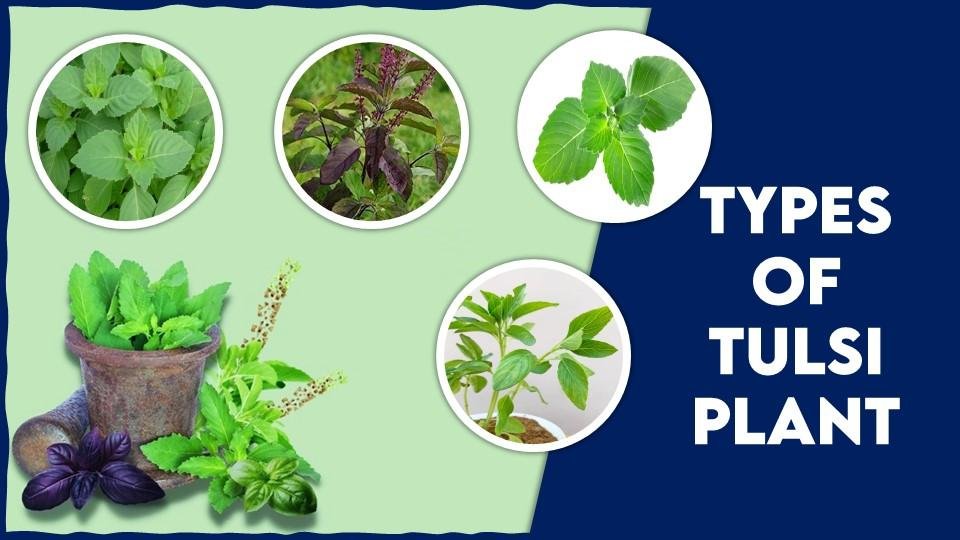If there is one plant in India that holds a mesmerizing religious, medicinal, and cultural significance such that the plant has a reserved position in every Indian household, it is the Tulsi plant. Its healing scent, smell, and vibrant blossoms can be felt and visualized in every Indian household. The plant grows naturally in India and is ubiquitous in the subcontinent.
But did you know there are 4 types of Tulsi plant or Holy Basil varieties in India? Do you know which type of Tulsi plant is best for your home? How to care for the Tulsi plant? These are some common questions floating in everyone’s mind.
Tulsi: Basic Facts
| Common name | Tulsi, Holy Basil |
| Botanical name | Ocimum tenuiflorum, Ocimum gratissimum |
| Nativity | Australia, Asia, Malesia, and the Western Pacific |
| Family | Lamiaceae |
| Plant type | Herbaceous perennial shrub (annual in colder and temperate climates) |
| Bloom time | Seasonal |
| Flower color | Purple or white colored small flowers |
| Leaves | Hairy, green to purple-red petioled leaves |
| Soil requirement | Well-draining moist, sandy loam soil |
| Soil pH | Can grow in acidic and alkaline soils |
| Climate | Tropical to sub-tropical climate |
| Sunlight requirement | Partial to full sunlight |
| Mature size | 1 to 2 feet wide and 2 feet tall |
| Major types | Rama Tulsi (Ocimum sanctum)Krishna Tulsi (Ocimum tenuiflorum)Vana Tulsi (Ocimum gratissum)Kapoor Tulsi (Ocimum tenuiflorum) |
The Tulsi plant parts are used by Hindu devotees to perform religious rituals. The Tulsi is an erect, herbaceous subshrub that grows up to 150 cm (60 in). A reduction in height occurs when the Tulsi is grown indoors or in mild climates. When grown indoors, the Tulsi attains a height of only 60 cm (24 in). The stem is branched and has numerous hairs on the surface. The leaves are simple, petioled, and have a toothed margin. The leaves are green or purple colored with a soothing scent. The Tulsi plant can be grown indoors if sufficient light can be provided by placing them near windows.
Types of Tulsi Plant
Tulsi is cultivated in tropical, subtropical, and even temperate regions throughout. The cultivated Tulsi plants have different characteristics and are classified as different species within the genus Ocimum.
- Holy Basil: it is the type of tulsi found abundantly in India. Holy Basil has 4 popular species.
- Rama Tulsi (Ocimum sanctum)
- Krishna Tulsi (Ocimum tenuiflorum)
- Vana Tulsi (Ocimum gratissum)
- Kapoor Tulsi (Ocimum tenuiflorum)
- Mediterranean Basil: the Mediterranean basil is more popular than the Holy Basil and is found in Asia, Europe, America, and Africa. Unlike the Holy Basil varieties that are revered for their medicinal properties, the Mediterranean Basil is popular for their culinary uses. There are many species under the Mediterranean Basil.Sweet basil (Ocimum basilicum)
- Thai basil (Ocimum thyrsiflora)
- Purple basil (Ocimum basilicum)
- Lemon basil (Ocimum citriodorum)
- Vietnamese basil (Ocimum cinnamon)
- American basil (Ocimum amricanum)
1. Rama Tulsi
| Botanical name | Ocimum sanctum |
| Common names | Green leaf tulsi, Sri or Lakshmi tulsi |
| Soil requirement | Sandy loam soil with good organic matter |
| Light requirement | Full sunlight |
| Water requirement | Regular irrigation except in winter |
| Temperature range | 15 to 40 degrees Celsius |
The Ram Tulsi, also known as the Green leaf Tulsi or the Sri or Lakhmi Tulsi is found in China, Brazil, Eastern Nepal, and India in Bihar, Bengal, Chatgaon, and Southern states of India. The leaves, when crushed using hands produce an aroma that is stronger than the other varieties of Holy Basil.
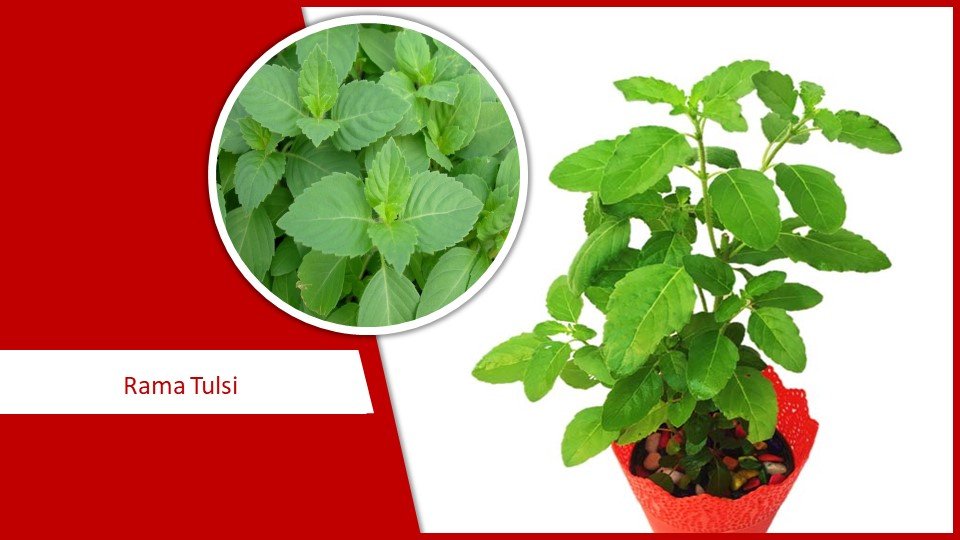
The plant is resilient and can tolerate winters and summers. The water and fertilizer requirement is high for Ram Tulsi in the case of commercial cultivation. Rama Tulsi is popular for its sweet, mellow taste. It is a religious icon and the presence of Rama Tulsi in your homes is believed to attract wealth and prosperity to your homes. The plant is best for growing outdoors since it is a sun-loving plant.
2. Krishna Tulsi
| Botanical name | Ocimum tenuiflorum |
| Common names | Krishna Tulsi, Shyama Tulsi, Purple leaf Tulsi |
| Soil requirement | Organic matter rich sandy loam soil |
| Light requirement | Full sunlight is best |
| Water requirement | Water daily except during winter months |
| Temperature range | 20 to 45 degrees Celsius |
The Krishna Tulsi can easily be identified by their purple-colored leaves and dark purple stems. Due to this purple coloration, they are also called purple leaf Tulsi. The flowers are small elongated racemes present in close whorls and are purple.
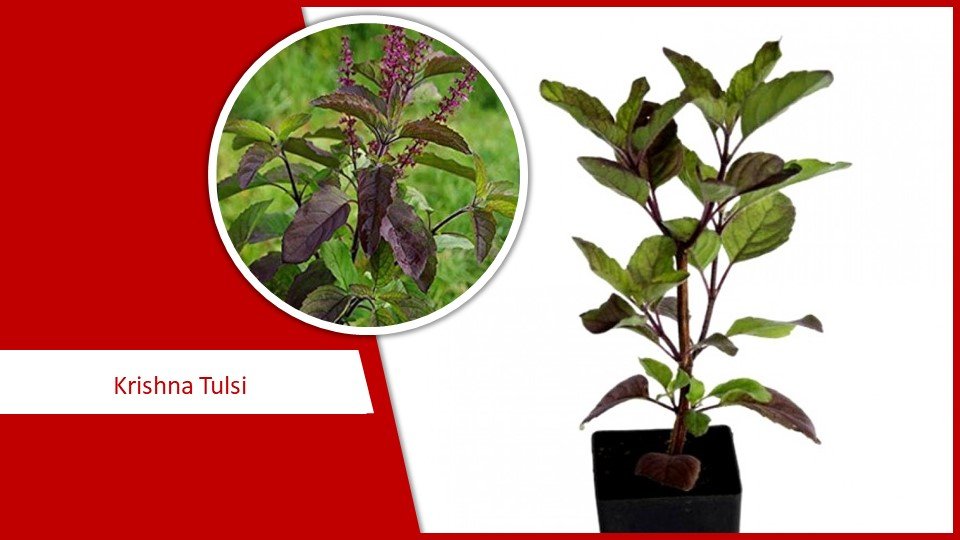
Krishna Tulsi requires organic-rich soil for its cultivation and requires full sunlight. Sowing is done during the spring season. Regular watering is a must in the initial years but can be reduced to 2-3 times a week after establishment.
3. Vana Tulsi
| Botanical name | Ocimum gratissum |
| Common names | Wild leaf Tulsi |
| Soil requirement | Well-drained nutrient rich soil |
| Light requirement | Full sunlight |
| Water requirement | Water daily except in winters |
| Temperature range | 15 to 40 degrees Celsius |
A wild variant of the Holy Basil, the Vana Tulsi or Wild leaf Tulsi is native to India and East Africa. The strong aroma of the plant can be detected from 100 meters away. Vana Tulsi produces small, tubular, white, or purple flowers with green or pinkish sepals.
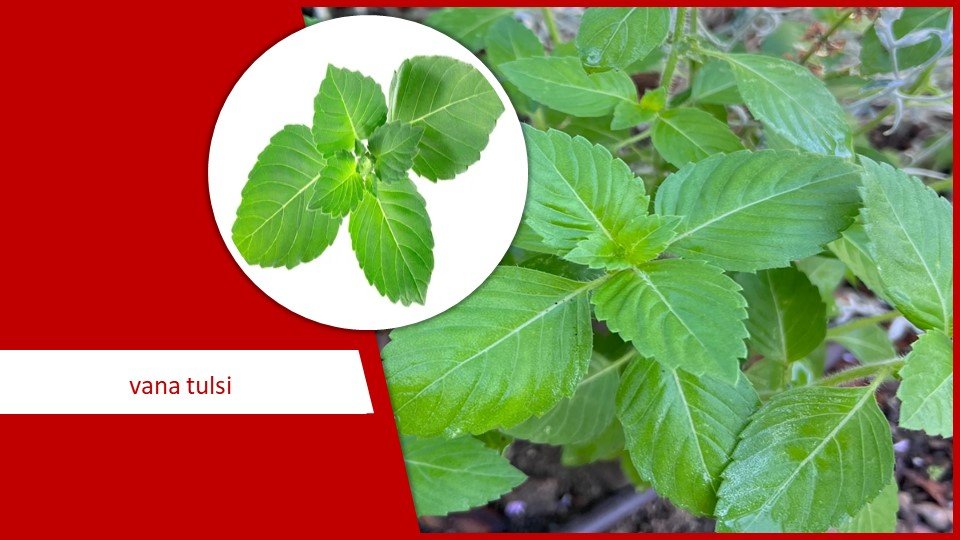
The plant requires well-drained nutrient-rich soils with neutral pH soils having pH range between 6.0 and 7.5. They love direct sunlight and require a total of 4 hours of direct sunlight per day. During winter it is best to grow indoors in a sunny spot having a temperature of at least 10 degrees Celsius. Watering should be done when the soil becomes dry in the summer and should be reduced during winter.
4. Kapoor Tulsi
| Botanical name | Ocimum tenuiflorum |
| Common names | Kapoor Tulsi |
| Soil requirement | Well-drained nutrient rich soil |
| Light requirement | Full sunlight |
| Water requirement | Frequent irrigation in summers and reduce it during winters. |
| Temperature range | 15 to 40 degrees Celsius |
Kapoor Tulsi was introduced to the United States because of its numerous health benefits and is now the most common Holy Basil found in the United States. Kapoor Tulsi is a short, heavily flowered plant. It can be grown as both annual and perennial depending on the conditions. They have a characteristic sweet fragrance that is insect repellant and can drive away disease-causing mosquitoes.
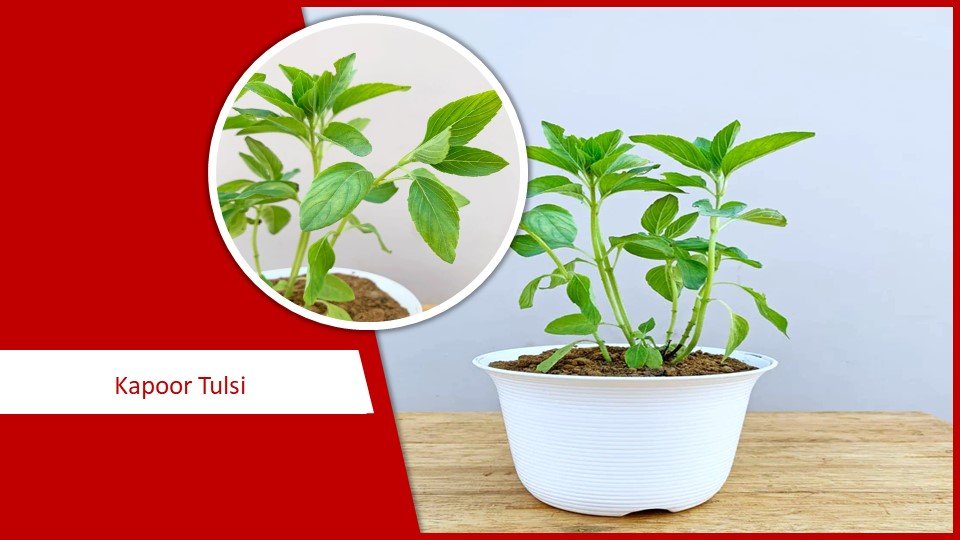
The seeds of Kapoor Tulsi germinate quickly and are sown in the spring season. The seeds germinate in one to two weeks with adequate watering. Kapoor Tulsi favors a temperate climate, nutrient-rich soil, and full sunlight for its growth. Watering should be done in such a way that the soil does not become dry, hardened, or compact. Kapoor Tulsi is used in both Indian and Thai cuisines as a spice in stir-fries, rice, seafood, and sauces. It is also an infamous medicinal herb that acts as a remedy for life-threatening diseases.
That’s all about the Holy Basil varieties. Now let’s look at the medicinal uses, other uses, and cultural uses of the Tulsi plant.
Also Read
- Types of Ferns in India
- Earn up to 3 lakhs in 3 months through Tulsi Farming
- How To Make Rosemary Oil at Home
Medicinal Uses of Tulsi Plant
They are a part of Ayurveda, Siddha, and Unani medicine in India. So let us look at some important medicinal uses of the Tulsi plant
- Tulsi is an antipyretic and an analgesic meaning they can reduce fever and pain because of their anti-bacterial and anti-viral properties. The juice from Tulsi leaves can be added with pepper powder or cardamom and consumed to reduce fever.
- Tulsi contains the chemicals camphene, cineole, and eugenol which can cure respiratory disorders and chest congestion.
- Ocimumocides A and B present in Tulsi balance the serotonin and dopamine levels in the brain, thus reducing anxiety and stress.
- The plant has diuretic properties, that is it can reduce the amount of Uric acid in the body and hence prevent the formation of Kidney stones.
- The anti-oxidant-rich Tulsi plant extract can clear acne and blemishes from the skin giving a spot-free glowing skin and can prevent premature aging.
- They are used to treat hair loss as their use can strengthen hair roots.
- Dried Tulsi leaves can be mixed with food grains to act as an insect repellant.
Other Uses
- The dried leaves of Tulsi can be mixed with food grains to act as insect repellant.
- The sweet aroma of Tulsi produced due to the presence of beneficial volatile oils has a coming effect and is thus used for Aromatherapy.
- Tulsi oil is used in the production of Herbal toiletries such as soaps, toothpaste, hand washes, lotions, and mouthwashes.
- The vibrant leaves and aromatic blossoms add aesthetic value to any Garden space and hence is a great plant to be considered for your garden.
Cultural Importance of Tulsi Plant
Tulsi is a sacred plant in Hinduism. The plant is known as Vrinda as it is considered by Hindus to be the entrance to Vaikuntha, the heavenly realm of the gods. Several Gods and Goddesses are believed to be present in certain parts of the planet. According to Hindu tradition, the plant is the actual manifestation of Goddess Lakshmi. Because of these specialties, the Hindu plant is given God-like respect in Hinduism.
Growing Tulsi Indoors
Which Type of Tulsi Plant is Best for Your Home?
For growing inside your homes you can choose either Rama Tulsi (Green leaf Tulsi) or Krishna Tulsi (Shyama Tulsi). According to Vastu Shastra, the Green tulsi is best for growing in your home. Due to the cultural significance of the Tulsi plant, it is imperative to grow at least one Tulsi plant in one home.
How to Take Care of Tulsi Plant at Home?
Proper sunlight, irrigation, and fertilization are essential if you are planning to grow Tulsi indoors.
- Sunlight: Tulsi is a sun-loving plant and requires 6-8 hours of direct sunlight every day. Hence it should be ensured that the position of the plant is such that it gets abundant sunlight. The plant has to be protected from the tough afternoon sun.
- Soil :The plant requires nutrient-rich well-draining soil for good growth.
- Watering : Sufficient watering is necessary to maintain the plant. Water the plant whenever the soil gets dry and compact. Regular watering at least once in 2 days is a must in the summer months. However, the frequency of watering should be reduced to twice or thrice a week in winter.
- Manuring : Add organic manure at sufficient levels. Organic manures are preferable to chemical fertilizers. The manuring must be done once a month.
- Pest control: Aphids and spider mites are common pests of the Tulsi plant. Monitor the plant for any occurrence of the pest and wash the plant part with soapy water in case of incidence.
One point that can easily be construed from the elaborate article above on the Tulsi plant is that the Tulsi plant is an absolute necessity in every home. It has often been naively seen just as an invasive plant and was removed frequently. Hence it is important to understand the numerous benefits that this gem of a plant provides to conserve it and grow it in all our homes.
Frequently Asked Questions
1. Where should I keep the Tulsi plant in my home?
The Tulsi plant requires extensive sunlight in the range of 4-6 hours. So, the plant should be kept in such a position in your home that it requires sufficient sunlight and is protected from the scorching afternoon sun.
2. Can Tulsi grow inside a home?
Yes absolutely! With proper sunlight, irrigation, manuring, and pest and disease control, this splendid plant can be grown in any home.
3. When should I plant Tulsi in my home?
It is best to plant the Tulsi plant in the spring as the temperature and the conditions are just right to support the plant growth. However, as the plant is grown indoors, it is possible to plant the Tulsi at any time if you can give adequate care to it.
Latest Post
- June Issue (2025) – Times of Agriculture Magazine
- How to Create Modern Commercial Greenhouse Agriculture
- REACH NEW HEIGHTS WITH YOUR BUSINESS AT VIETSTOCK EXPO & FORUM 2025
- Revamping Waste: A wish list This World Environment Day
- Types of Banana in India : Health & wallet friendly fruit
- May Issue (2025): Times of Agriculture
- How to Grow Oyster Mushrooms at Home in India
- Top 10 Profitable Fruit Farming in India
- 5 Unique Hobby Farm Animals You Should Consider Domesticating

